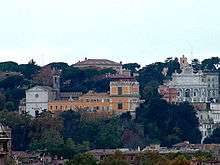Janiculum
The Janiculum /dʒəˈnɪkjʊləm/ (Italian: Gianicolo [dʒaˈniːkolo]) is a hill in western Rome, Italy. Although it is the second-tallest hill (the tallest being Monte Mario) in the contemporary city of Rome, the Janiculum does not figure among the proverbial Seven Hills of Rome, being west of the Tiber and outside the boundaries of the ancient city.
| The Janiculum | |
|---|---|
| Hill of Rome | |
| Latin name | Iāniculum |
| Italian name | Gianicolo |
| Rione | Trastevere |
| Buildings | Academia de España in Rome, American Academy in Rome, Acqua Paola, Water Mill (site) |
| Churches | San Pietro in Montorio, San Pancrazio |
| Events | 1849 battle |
| Ancient Roman religion | augurs |
| Mythological figures | Janus |

Sights
The Janiculum is one of the best locations in Rome for a scenic view of central Rome with its domes and bell towers. Other sights on the Janiculum include the church of San Pietro in Montorio, on what was formerly thought to be the site of St Peter's crucifixion; a small shrine known as the Tempietto, designed by Donato Bramante, marks the supposed site of Peter's death. The Janiculum also houses a Baroque fountain built by Pope Paul V in the late 17th century, the Fontana dell'Acqua Paola, and several foreign research institutions, including the American Academy in Rome and the Spanish Academy in Rome. The Hill is also the location of The American University of Rome, Pontifical Urban University, and Pontifical North American College, as well as the Orto Botanico dell'Università di Roma "La Sapienza" and the Palazzo Montorio, residence of the Ambassadors of Spain.
The Villa Lante al Gianicolo by Giulio Romano (1520–21) is an important early building by the Mannerist master, also with magnificent views.
History
Ancient history and mythology
The Janiculum was a center for the cult of the god Janus: its position overlooking the city made it a good place for augurs to observe the auspices.
In Roman mythology, Janiculum is the name of an ancient town founded by the god Janus (the two-faced god of beginnings). In Book VIII of the Aeneid by Virgil (Publius Vergilius Maro), King Evander shows Aeneas (the Trojan hero of this epic poem) the ruins of Saturnia and Janiculum on the Capitoline Hill near the Arcadian city of Pallanteum (the future site of Rome) (see line 54, Bk. 8). Virgil uses these ruins to stress the significance of the Capitoline Hill as the religious center of Rome.
According to Livy, the Janiculum was incorporated into ancient Rome during the time of king Ancus Marcius to prevent an enemy from occupying it. It was fortified by a wall, and a bridge was built across the Tiber to join it to the rest of the city.[1]
During the war between Rome and Clusium in 508 BC, it is said that the forces of Lars Porsena occupied the Janiculum and laid siege to Rome.[2]
The water mills
The Aurelian Walls were continued up the hill by the emperor Aurelian (reigned AD 270–275) to include the water mills used to grind grain to provide bread flour for the city. The mills were supplied from an aqueduct, where it plunged down a steep hill. Thus the site resembles Barbegal, although excavations in the late 1990s suggest that they may have been undershot rather than overshot in design (i. e. with the stream entering at the bottom of the wheel, not the top). The mills were in use in AD 537, when the Goths besieging the city cut off their water supply. But they were later restored and may have remained in operation until at least the time of Pope Gregory IV (827–844).[3]
19th century to present
The Janiculum is the site of a battle in 1849 between the forces of Garibaldi, defending the revolutionary Roman Republic against French forces, who were fighting to restore the temporal power of the Pope over Rome. Several monuments to Garibaldi and to the fallen in the wars of Italian independence are on the Janiculum.
Daily at noon, a cannon fires once from the Janiculum in the direction of the Tiber as a time signal. This tradition goes back to December 1847, when the cannon of the Castel Sant'Angelo gave the sign to the surrounding belltowers to start ringing at midday. In 1904, the ritual was transferred to the Janiculum and continued until 1939. On 21 April 1959, popular appeal convinced the Commune of Rome to resume the tradition after a twenty-year interruption.
The hill is featured in the third section of Ottorino Respighi's famous orchestral piece The Pines of Rome.
Monuments
The crest of the Janiculum is dominated by the 1895 equestrian Monument to Garibaldi, designed by Italian sculptor Emilio Gallori. This site was chosen for its proximity to the Villa Doria Pamphili, where Garibaldi mounted a military defense of the short-lived Roman Republic in late April 1849.[4]
The hill also features a number of statues and monuments of prominent Italians. A 2011 guide published by the local Associazione Amilcare Cipriani group, after an extensive restoration of these monuments, lists a total of 84 busts on the hill.[5]
See also
- Seven hills of Rome
- Aventine Hill (Aventino)
- Caelian Hill (Celio)
- Capitoline Hill (Capitolino)
- Cispian Hill (Cispio)
- Esquiline Hill (Esquilino)
- Monte Mario
- Oppian Hill (Oppio)
- Palatine Hill (Palatino)
- Palazzolo
- Pincian Hill (Pincio)
- Quirinal Hill (Quirinale)
- Vatican Hill (Vaticano)
- Velian Hill (Velia)
- Viminal Hill (Viminale)
References
- Livy, Ab urbe condita, 1:33
- Livy, Ab urbe condita, 2.9–15
- Örjan Wikander, 'Water-mills in Ancient Rome' Opuscula Romana XII (1979), 13–36.
- The Architecture of Modern Italy: Vol. 1: The Challenge of Tradition, 1750-1900, by Terry Kirk, 2005, page 239
- http://www.appasseggio.it/getFile.php?id=306 (Italian-language; pdf file)
External links
| Wikimedia Commons has media related to Janiculum. |